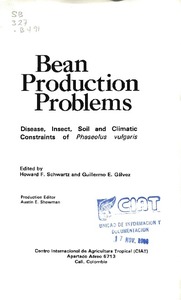Realiza una revisión crítica de las teorías tradicionales de marginalidad urbana y del tratamiento que hacen de las dimensiones ecológicas del fenómeno. Analiza el impacto de las diferentes formas de integración desigual en las áreas precarias y la intervención planificada en asentamientos…
Contiene los comentarios del autor sobre algunos aspectos del Primer Congreso Internacional de Planeación de Grandes Ciudades, realizado en México, junio de 1981. Presenta observaciones respecto a descentralización y políticas de pluralismo cultural, las áreas metropolitanas en el desarrollo…
Data are given of area planted to beans, production, and yields in the Andean countries during 1964-66, 1974-76, and 1978; production, trade, and consumption during 1963-65 and 1973-75; and production, area, and yield growth rates during 1966-76. Constraints for bean productivity, cropping…
Se detallan evaluaciones de campo e invernadero en las que se examinaron: el efecto de diferentes rocas fosforicas (RF), la eficacia de la aplicacion de P, el tamano de los granulos y las relaciones RF: Superfosfato triple, asi como los efectos de las mezclas cogranuladas de RF con superfosfato…
Drought stress was imposed on 2 cassava cv. (M Col 22 and M Mex 59) at Santander de Quilichao (Colombia), by withholding rainfall from field plots (plastic covers were placed over the soil surface) for 10 wk, commencing when crops were 12 wk old. The plants were then allowed to recuperate until…
Different nutritional deficiencies or toxicities may limit bean development and yield. N and P deficiencies are the most frequent, although deficiency of minor elements and Al/Mn toxicity can reduce yields considerably. Nutritional problems are usually diagnosed by soil and plant tissue analyses…
The progress achieved by CIAT's cassava program through training activities related to the crop in Latin America, Asia, and Oceania are given. In collaboration with the training office at the Centro Internacional de Agricultura Tropical, the cassava program in 1980 trained 38 professionals…
The progress achieved by CIAT's cassava program through training activities related to the crop in Latin America, Asia, and Oceania are given. In collaboration with the training office at the Centro Internacional de Agricultura Tropical, the cassava program in 1980 trained 38 professionals…
White mold, caused by the fungus Sclerotinia (Whetzelinia) sclerotiorum, is distributed worldwide and has more than 300 hosts. It infects flowers, cotyledons, seeds, leaves or injured plant tissue. The disease can be controlled by crop rotation, flooding, reduced seeding rates, application of…







